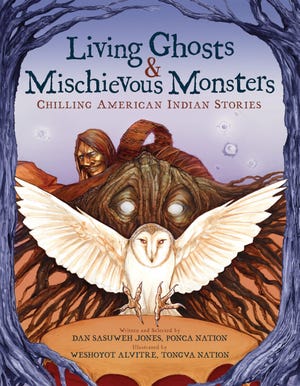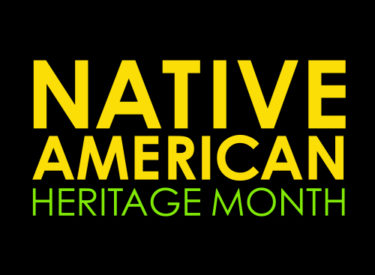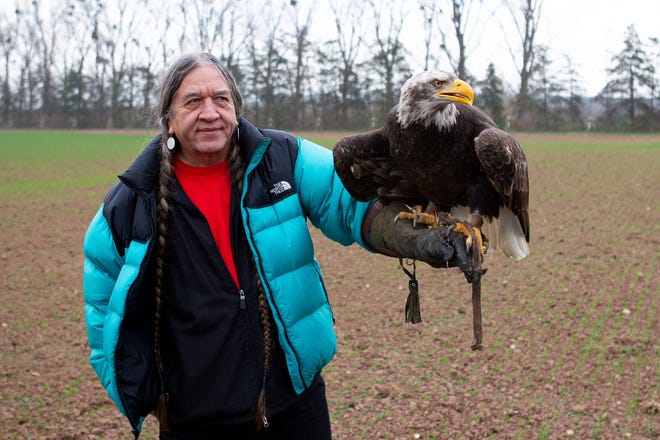A member of the Producers Guild of America, Jones has produced work for “Sesame Street,” NBC, TBS and other national and international networks. He worked as an honorary Imagineer and consultant for the Disney America theme park and as a field producer for the television miniseries “500 Nations,” produced by Kevin Costner.
Also a bronze sculptor, he and Enoch Kelly Haney (Seminole) teamed up to create a design for the National Native American Veterans Memorial; they were finalists in the 2018 competition, with fellow Oklahoma American Indian artist Harvey Pratt (Cheyenne-Arapaho) selected as the winning designer.
Along with working as a storytelling author and consultant for the 2019 “National Geographic Encyclopedia of the American Indian,” he published in 2005 his poetry volume “Blood of Our Earth” via the University of New Mexico Press. That book was illustrated by internationally known Comanche artist Ranch Hood, and Jones knew he wanted an indigenous illustrator for his first wide release, too.
“It had to be as far as I was concerned, just to capture a lot of the feelings that we’re dealing with,” he said. “I just found her artwork beautiful, so I was definitely eager to sign off.”
With the help of the Scholastic team, he selected author, comic book artist and illustrator Weshoyot Alvitre, who is from the Tongva tribe of Southern California, to create the visuals for “Living Ghosts & Mischievous Monsters.”

Wes Studi-Honorary Oscar-winning Actor was born in Nofire Hollow Oklahoma.
Scholastic also tapped Jones’ longtime friend and fellow Oklahoma native Wes Studi, the Honorary Oscar-winning Cherokee actor, along with Studi’s niece, fellow performer and Muldrow native Delanna Studi, to record the audiobook.
“Wes and I go back: We worked together on (the 1988 TV movie) ‘The Trial of Standing Bear’ when we shot it here … and his real estate has gone way up since he got his Academy Award. But I was just tickled that he was able to do it,” Jones said.
“My only thoughts to him were … it’s aimed for children, so have fun with it — and he went with that and did a wonderful job.”
Supernatural stories come from tribes across North America
Jones’ first book for children is intended for readers 8 to 12, an age group often fascinated with the mysterious and macabre.
“It’s both for Native American children that don’t really have an opportunity to get much of a view inside of their own cultures and also for non-Natives to get a better look at who we are as people — that we are people and these are touching human stories,” he said.
Working with Scholastic has been a wonderful experience, Jones said, leading to a two-book deal with the publisher. “Living Ghosts & Mischievous Monsters” received a starred review from Kirkus Reviews, which deemed it “Valuable both for its broad range and shivery appeal.”


“The doors that are opening from it are quite useful and quite interesting,” Jones said. “There’s just quite an interest in this whole subject for sure.”Ranging from tragic and terrifying to funny and whimsical, the stories are divided into five chapters: “Ghosts,” “Spirits,” “Witches,” “Monsters” and “The Supernatural.” Some of the legends, like La Llorona and especially Bigfoot, have made forays into the wider American culture, but most of the myths in the book have not.
“What really caught my attention was some creatures showing up in the far northwest and then showing up in the far southwest. … Stuff like that fascinated me,” Jones said.
Brock Battenfield relates the Tlingit people of Alaska’s tale of “The Kushtaka,” evil shape-shifters who are part human and part otter, while Luis Wicho Aguilar, of South Texas’ Western Carrizo Tribe, had to get his mother’s permission to share the legend of “La Lechuza, the Owl Witch.” Other stories come from the Micmac Tribe of northeast Canada, the Navajo Nation in the southwestern United States, and the Seminole, Ponca and Southern Cheyenne tribes now based in Oklahoma.
Although some are ancient legends that have been passed down over generations, others are recent accounts, including Jones’ opening story of his Great-Aunt Agnes’ final morning visit to his childhood home.
“Some of these have stuck with me a long time,” Jones said. “They often say that ghosts appear where these great tragedies have occurred — battlefields and things like that — so they are just unforgettable experiences.”





